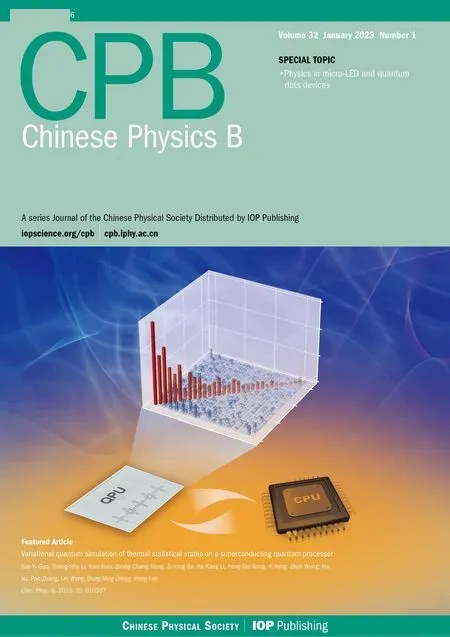Thickness-dependent magnetic properties in Pt/[Co/Ni]n multilayers with perpendicular magnetic anisotropy
2023-02-20ChunjieYan晏春杰LinaChen陈丽娜KaiyuanZhou周恺元LiupengYang杨留鹏QingweiFu付清为WenqiangWang王文强WenChengYue岳文诚LikeLiang梁力克ZuiTao陶醉JunDu杜军YongLeiWang王永磊andRonghuaLiu刘荣华
Chunjie Yan(晏春杰), Lina Chen(陈丽娜),2,†, Kaiyuan Zhou(周恺元), Liupeng Yang(杨留鹏), Qingwei Fu(付清为),Wenqiang Wang(王文强), Wen-Cheng Yue(岳文诚), Like Liang(梁力克), Zui Tao(陶醉), Jun Du(杜军),Yong-Lei Wang(王永磊), and Ronghua Liu(刘荣华),‡
1National Laboratory of Solid State Microstructures,School of Physics and Collaborative Innovation Center of Advanced Microstructures,Nanjing University,Nanjing 210093,China
2School of Science,Nanjing University of Posts and Telecommunications,Nanjing 210023,China
3School of Electronics Science and Engineering,Nanjing University,Nanjing 210093,China
Keywords: perpendicular magnetic anisotropy,magnetic domain,damping,multiayers
1. Introduction
Magnetic multilayers with strong perpendicular magnetic anisotropy (PMA) and low magnetic damping have attracted much attention because of their potential applications in highdensity magnetic random access memories(MRAM)[1–5]and spin torque nano-oscillators.[6–9]Compared to the in-plane magnetized ferromagnets, ferromagnetic films with PMA facilitate the realization of nonvolatile MRAM with lower power and higher density storage because the latter has lower critical switching current and higher thermal stability than the former as the continuous downscaling of the cell size of devices.[10]In addition, PMA can be an effective magnetic field to achieve zero external magnetic field working spintorque nano-oscillators with ferromagnets with strong PMA and low damping as its free layer.[11]Therefore, the controllable tailoring PMA of magnetic films is an essential prerequisite for developing high-performance spintronic devices.The magnetic multilayers,e.g.,[Co/Pd],[Co/Pt],and[Co/Ni],provide an opportunity to tune their magnetic properties by changing the thickness ratio controllably and the number of bilayer repeats thanks to the interface-induced PMA due to interfacial spin–orbit coupling and interfacial strain relevant magnetoelastic effects.[12–17]Among these PMA multilayers, the PMA [Co/Ni] multilayer also exhibits low damping constant,[14]which gets much attention, especially for the fields of current-driven auto-oscillation of magnetization and excitation and manipulation of spin-waves.[18,19]Furthermore,the PMA[Co/Ni]multilayer is also useful for spin–orbit torque devices.[20–22]Therefore,[Co/Ni]multilayers are considered one of the most promising PMA ferromagnets in various spintronic devices.Although there are a few studies on the magnetic anisotropy, magnetotransport, and magnetic damping of Pt/[Co/Ni] multilayers,[6,14,23]the systematically studied evolution of magnetostatic properties,including the topography of magnetic domains and magnetic dynamics with the thickness ratio of Co and Ni layers for this multilayer film still needs to make a thorough investigation for facilitating it better used in further spintronics.
Here, we systematically investigate how to control the magnetic film PMA by tailoring the interfacial effect by varying the thickness of the Ni layer and its impact on magnetic domain structure and dynamical damping in two serial Co/Ni multilayers withtCo=0.2 nm and 0.3 nm. The highest PMA coefficientKU~3×106erg·cm-3and coercivityHC~250 Oe are found at the optimum Ni thicknesstNi=0.6 nm for the studied two serials.The nucleation of the magnetic domain occurs at only a few nucleation sites and gradually expands with magnetic fields for the multilayers with the optimum Ni thicknesses 0.4 nm–0.6 nm. Finally, the intrinsic Gilbert damping constantαis not sensitive to thickness-dependentKUand domain structures even though the linewidth of ferromagnetic resonance is inversely proportional toKUandHC, which is dominated by inhomogeneous magnetic properties.
2. Experiment
Two serial multilayers of Pt(5)/[Co(0.2)/Ni(tNi)]5/Pt(1)and Pt(5)/[Co(0.3)/Ni(tNi)]5/Pt(1),named as Pt/[Co(0.2)/Ni(tNi)]and Pt/[Co(0.3)/Ni(tNi)], respectively, were deposited on Si/SiO2substrates at room temperature by dc-magnetron sputtering with Ar pressure 3×10-3torr. The unit in parentheses is the thickness in nm. The base pressure of the sputtering deposition chamber is below 2×10-8torr. The deposition rate was monitored by the quartz crystal monitorin situand calibrated by spectroscopic ellipsometry(SE).The static magnetic properties were characterized by the vibrating sample magnetometer (VSM), the anomalous Hall resistivity (AHR)measurement,and the magneto-optic Kerr effect(MOKE)microscopy respectively. The films’ ferromagnetic resonance(FMR) spectra, obtained by combining coplanar waveguide(CPW) and lock-in techniques, were also adopted to characterize their dynamic magnetic properties. All these magnetic characterizations were performed at room temperature.
3. Results and discussion
3.1. Quasi-static magnetic properties
To directly obtain the thickness dependence of PMA properties in the Co/Ni films, we first performed the magnetic hysteresis loops of samples with different thicknesses using VSM. Figure 1 shows the magnetization hysteresis loops with the out-of-plane and in-plane field geometries for the two serial multilayers of Pt/[Co(0.2)/Ni(tNi)] and Pt/[Co(0.3)/Ni(tNi)] samples. The well-defined squareM–Hloops under out-of-plane field [Figs. 1(a) and 1(c)] indicate that two studied serial Pt/[Co/Ni] multilayers exhibit a perpendicular magnetic anisotropy. Additionally, the saturation magnetizationMSof the multilayers decreases with increasing the thickness of the Ni layertNi, from 673 emu·cm-3to 495 emu·cm-3for Pt/[Co(0.2)/Ni(tNi)]and 723 emu·cm-3to 639 emu·cm-3for Pt/[Co(0.3)/Ni(tNi)], which agrees with the much lowerMS~484 emu·cm-3of the metal nickel compared to that of the cobalt layerMS~1422 emu·cm-3.Based on the out-of-plane and in-plane magnetization hysteresis loops, the perpendicular anisotropy fieldHKwas determined by using the defined formula for the PMA:[12,24]HK=(2/MS)(H⊥dM-H‖dM)+4πMS. The calculatedHK,MSand the coercivityHC, obtained from theM–Hloops,were summarized below in Fig.5.
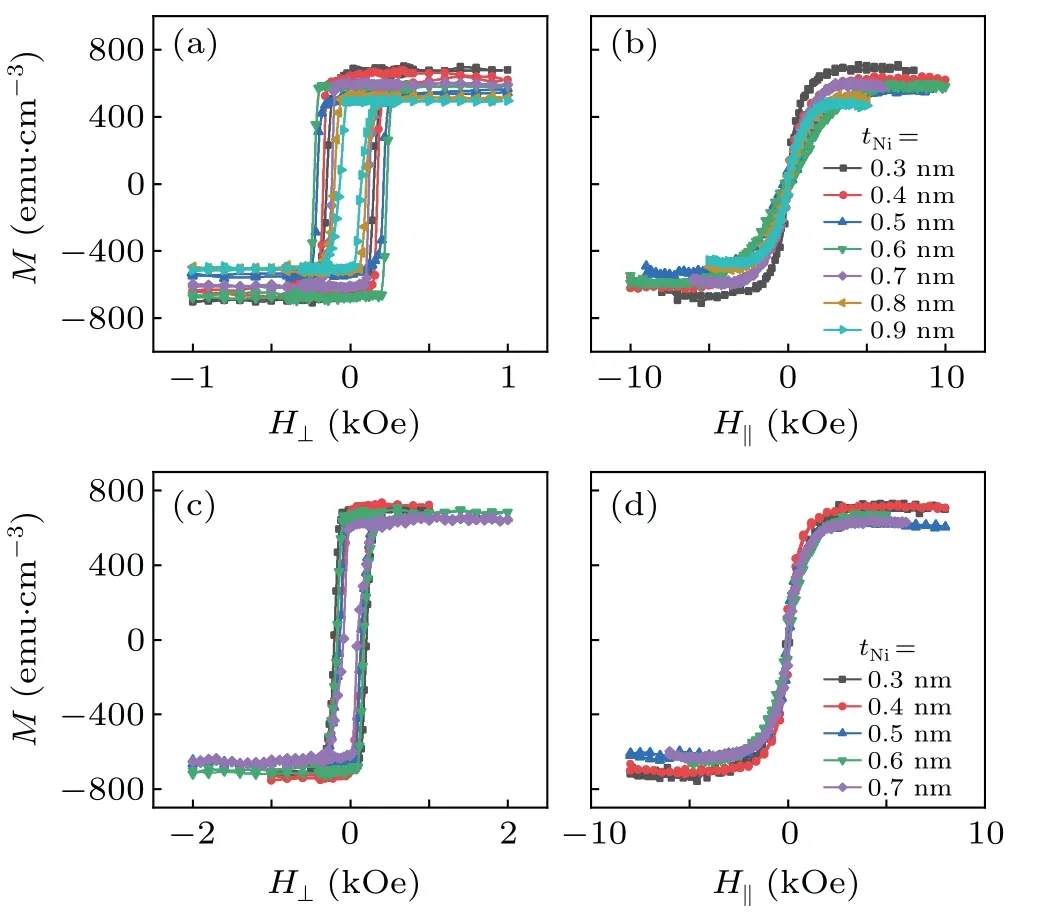
Fig.1.(a)–(b)Magnetization loops of the films Pt(5)/[Co(0.2)/Ni(tNi)]5/Pt(1)with out-of-plane(a)and in-plane(b)magnetic field.(c)–(d)Same as(a)–(b),for Pt(5)/[Co(0.3)/Ni(tNi)]5/Pt(1).
These static magnetic properties of the metal Pt/[Co/Ni]multilayer films also can be determined by the electric transports in magnetic field,e.g.,anomalous Hall resistivity(AHR)and magnetoresistive effect. Compared to the standard magnetometer above,the electric transports in magnetic field measurements provide an alternative approach and, especially,more useful for spintronic nano-devices because they can easily access the magnetic properties of the microscale and nanoscale samples.[25,26]Therefore, we also perform the outof-plane and in-plane AHR loops as a function of the applied magnetic fields for the studied two serial multilayers,as shown in Fig.2. The coercivityHCdetermined from the outof-plane AHR loops are well consistent with the values obtained by theM–Hloops, and are also summarized in Fig.5.Meanwhile, we can calculateHKof the studied films from the in-plane AHR loops by using the following relation:[27]HK=H‖·tanarcsin(ρxy(H)/ρxy(0))+4πMS,whereρxy(0)is the AHR value at zero in-plane field. The evolution ofHKwith the thickness of the Ni layer is overall consistent with the results determined by the VSM measurement. Furthermore,the AHR measurements also provide us the additional information, which can not be easily accessed by VSM,about the studied two serial Pt/[Co/Ni] multilayers. For example, we find that the in-plane AHR near-zero magnetic field is much smaller than the out-of-plane AHR for the samples with certain Ni thickness,indicating that these samples form the multidomain structures at the low in-plane magnetic fields. Therefore,the value of the difference between out-of-plane and inplane AHR at near-zero fields hints that the different Ni thickness films may exhibit distinct magnetic domain structures.[28]
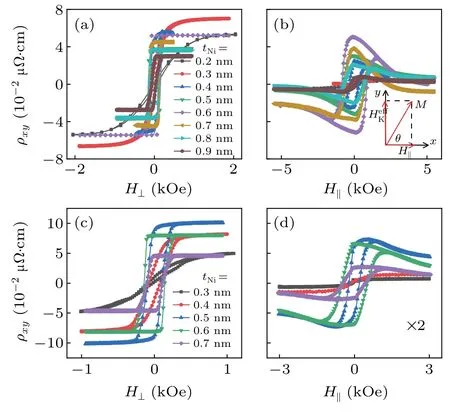
Fig.2. (a)–(b) Anomalous Hall resistivity as a function of out-of-plane(a) and in-plane magnetic field with 5° tilt angle from the file plane(b) for the samples Pt(5)/[Co(0.2)/Ni(tNi)]5/Pt(1). The inset shows the geometric relationship between magnetic field, magnetization and effective anisotropic field = HK-4πMS. (c)–(d) Same as (a)–(b), for Pt(5)/[Co(0.3)/Ni(tNi)]5/Pt(1). All AHR were measured by using the films patterned into a 0.3×10 mm Hall cross.
3.2. Magnetic domain structures


Fig.3.(a)–(h)Magneto-optic Kerr hysteresis loops and magnetic domain images of the films Pt(5)/[Co(0.2)/Ni(tNi)]5/Pt(1) with labeled thickness tNi =0.2 nm(a),0.3 nm(b),0.4 nm(c),0.5 nm(d),0.6 nm(e),0.7 nm(f),0.8 nm(g), 0.9 nm (h), respectively. The corresponding magnetic domain images with the size of 100 μm×150 μm were obtained at the labeled out-of-plane magnetic fields(also marked as the red dots on loops).
3.3. Magnetization dynamics
To further investigate the Ni thickness-dependent magnetization dynamics of Co/Ni multilayers,we perform the broadband FMR measurement with the external field perpendicular to the film plane. All FMR measurements were carried out with a home-made differential FMR measurement system combining lock-in technique at room temperature. A continuous-wave Oersted field with a selected radio frequency is generated via connecting coplane waveguide (CPW) with an RF generator, which produces a microwave signal to excite FMR of ferromagnetic film, which with film surface was adhered on the CPW. The RF power used in the experiments is 15 dBm. To improve the signal-to-noise ratio (SNR), a lock-in detection technique is employed through the modulation of signals. The modulation of a direct current(DC)magnetic fieldHis provided by a pair of secondary Helmholtz coils powered by an alternating current (AC) source with 129.9 Hz[see Fig.4(a)].[16,30]The differential absorption signal is measured by sweeping the magnetic field with a fixed microwave frequency. The representative FMR spectrum of Pt(5)/[Co(0.2)/Ni(0.3)]5/Pt(1) obtained at 9 GHz is shown in the inset of Fig. 4(b). The differential FMR spectrum can be well fitted by using a combination of symmetric and antisymmetric Lorentzian function,as follows:
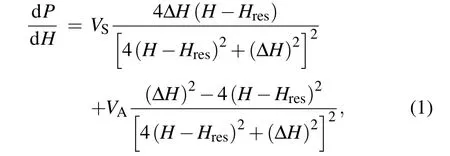
whereVSandVArepresent the symmetric and antisymmetric factors,His the external magnetic field,Hresis the resonance field,and ΔHis the linewidth of FMR correspondingtimes of the peak-to-dip width in the FMR spectrum. The relationship between the frequencyfand the resonance fieldHresof the two series of Pt/[Co(0.2)/Ni(tNi)]and Pt/[Co(0.3)/Ni(tNi)]samples [Figs. 4(b) and 4(d)] can be well fitted by the Kittel equation[31]

where(γ/2π)=2.8 MHz·Oe-1is the gyromagnetic ratio,Heffis the effective demagnetization[32]Heff=HK-4πMS.Therefore,the magnetic anisotropy fieldHKalso can be directly determined from the dispersion relation offversusHresby using a parameterMSobtained by VSM.In addition,we can obtain the intrinsic Gilbert dampingαby fitting the experimental data of linewidth ΔHversus resonance frequency [Figs. 4(c) and 4(e)] with the formula ΔH=ΔH0+(4πα f/γ), where ΔH0is an inhomogeneous linewidth independent of the frequency,and the second term is the intrinsic linewidth linearly proportional to the frequency. The inhomogeneous linewidth of samples is derived from roughness, defects and inhomogeneous PMA and magnetization.[33]

Fig.4.(a)Differential FMR spectra experimental setup.(b)Dependence of the resonance field Hres on the frequency f with the out-of-plane field for the films Pt(5)/[Co(0.2)/Ni(tNi)]5/Pt(1).Solid lines indicate the Kittel fitting curves.The inset is the representative FMR spectrum obtained at 9 GHz,which can be well fitted by Eq. (1) (solid red line). (c) The linewidth versus frequency (symbols) for the samples Pt(5)/[Co(0.2)/Ni(tNi)]5/Pt(1).The solid line is a linear fitting, which can extract the corresponding damping constant α based on Eq.(2). (d)–(e) Same as (b)–(c), for the films Pt(5)/[Co(0.3)/Ni(tNi)]5/Pt(1).
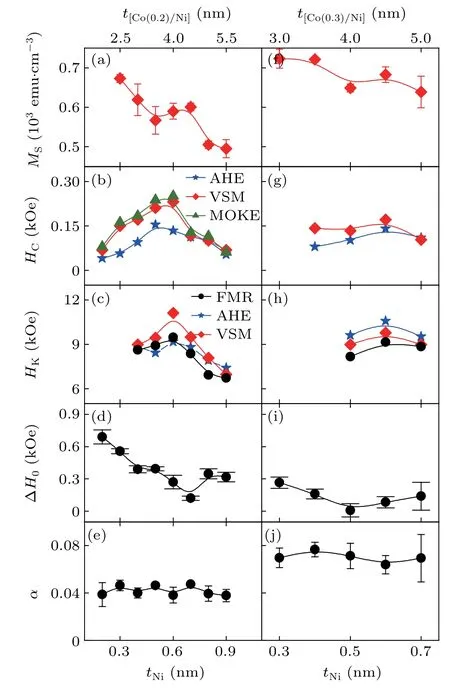
Fig.5. (a)–(e) Dependence of the saturation magnetization MS (a), the coercivity HC (b), the anisotropy field HK (c), the inhomogeneous linewidth ΔH0 (d)and the magnetic damping constant α (e)on the Ni thickness tNi in the films Pt(5)/[Co(0.2)/Ni(tNi)]5/Pt(1). (f)–(j)Same as(a)–(e)for the samples Pt(5)/[Co(0.3)/Ni(tNi)]5/Pt(1). MS, HC, and HK were determined from the previous magnetization loops, AHR loops, MOKE loops, and the ferromagnet resonance spectra. The linewidth was determined by fitting the experimental FMR spectrum with a Lorentzian function based on Eq.(1). The magnetic damping constant was obtained by a linear fitting of ΔH versus f curves based on Eq.(2).
Figure 5 summarizes the dependence of the determined material parameters: the saturation magnetizationMS, the coercivityHC, the anisotropy fieldHK, the inhomogeneous linewidth ΔH0and the magnetic damping constantαon Ni thicknesstNifor the studied two series of Pt/[Co(0.2)/Ni(tNi)]and Pt/[Co(0.3)/Ni(tNi)]samples. The determinedHKby three independent methods shows an overall consistent behavior.TheHKbegins to increase with increasingtNi, and reaches the maximum attNi~0.6 nm, whereafter reduces again with continuing to increasetNi. Several reasons account for this phenomenon. First, the magnetic anisotropy of the studied multilayer is mainly contributed from the interfacial magnetic anisotropy of the Co/Ni and Pt/Co interfaces.[34]Second, the Co/Ni multilayers’interface quality depends highly on the Ni layer’s thickness. In other words, too thin nickel layer may not get a good Co/Ni interface due to inevitable elements diffusion during sputtering deposition. However, theHKwill drop due to reducing the ratio of the interfacial anisotropy to the volume anisotropy energy if the Ni layer is too thick.LikeHK, theHCshows a similar trend with varying thickness of the Ni layer. As we well know that the coercivity depends on PMA,as well as defects-induced pinning effects.But, in our case, the results show that the combination of PMA and magnetization-relevant demagnetization field dominate the coercivity,which can be well explained by the Brown formula:[35]HC=(2KU/MS)-NMS,whereKU=(MSHK)/2 andNare the magnetic anisotropy constant and the demagnetization factor of the film,respectively.
Figures 5(d) and 5(i) show the inhomogeneous linewidth (ΔH0) of FMR spectra as a function oftNifor Pt/[Co(0.2)/Ni(tNi)] and Pt/[Co(0.3)/Ni(tNi)], respectively.For thin thickness Ni samples, island structures are most likely formed. This results in a broadening of the resonance linewidth due to a distribution of effective internal anisotropy and demagnetization fields.[37]One can see that the minimum linewidth of two serial samples corresponds to the maximum PMA fieldHK, suggesting the inhomogeneous magnetic anisotropy-induced linear broadening is the minimum at the optimum PMA condition.[36]Although the intrinsic damping constant is almost independent of the Ni thickness for the studied two serials, but the Pt/[Co(0.2)/Ni(tNi)] films have a lower damping constantα~0.04 thanα~0.07 of Pt/[Co(0.3)/Ni(tNi)]. The obvious difference in damping constant between the two serial multilayer systems indicates that the former has better magnetic dynamic properties.
4. Conclusion
The Ni thickness effect on the static magnetic properties and magnetic dynamics of Pt(5 nm)/[Co(0.2 nm and 0.3 nm)/Ni(tNi)]5/Pt(1 nm) multilayers demonstrate that the two studied serial multilayer systems exhibit the optimum PMA coefficientKUwell as the highest coercivityHCat the Ni thicknesstNi=0.6 nm.The MOKE images further confirm that the maximumKUcorresponds to the magnetic domain structure with the shortest length of domain wall through minimizing the total energy,which consists of magnetic anisotropy energy, exchange energy, and demagnetization energy. Furthermore, the frequency-dependent FMR spectra show that the damping constant remains almost constant with the different Ni thicknesses for both serials,but the Pt/[Co(0.2)/Ni(tNi)]multilayer serial has a lower damping constantα~0.04 than 0.07 of the Pt/[Co(0.3)/Ni(tNi)] serial. According to the obtained results, we find that the optimum PMA coefficientKU=3.3×106erg·cm-3,the highest coercivityHC=250 Oe,and as well as the lowest damping constantα=0.04 can be achieved at Pt(5)/[Co(0.2)/Ni(0.6)]5/Pt(1). Our results of optimizing magnetic properties of the Pt/[Co/Ni] multilayer by tuning the ratio of Co/Ni layers is helpful to facilitate its applications in various spintronic devices.
Acknowledgments
Project supported by the National Natural Science Foundation of China(Grant Nos.11774150,12074178,12004171,12074189, and 51971109), the Applied Basic Research Programs of Science and Technology Commission Foundation of Jiangsu Province, China (Grant No. BK20170627), the National Key Research and Development Program of China(Grant No. 2018YFA0209002), the Open Research Fund of Jiangsu Provincial Key Laboratory for Nanotechnology, and the Scientific Foundation of Nanjing University of Posts and Telecommunications(NUPTSF)(Grant No.NY220164).
猜你喜欢
杂志排行
Chinese Physics B的其它文章
- LAMOST medium-resolution spectroscopic survey of binarity and exotic star(LAMOST-MRS-B):Observation strategy and target selection
- Vertex centrality of complex networks based on joint nonnegative matrix factorization and graph embedding
- A novel lattice model integrating the cooperative deviation of density and optimal flux under V2X environment
- Effect of a static pedestrian as an exit obstacle on evacuation
- Chiral lateral optical force near plasmonic ring induced by Laguerre–Gaussian beam
- Adsorption dynamics of double-stranded DNA on a graphene oxide surface with both large unoxidized and oxidized regions
